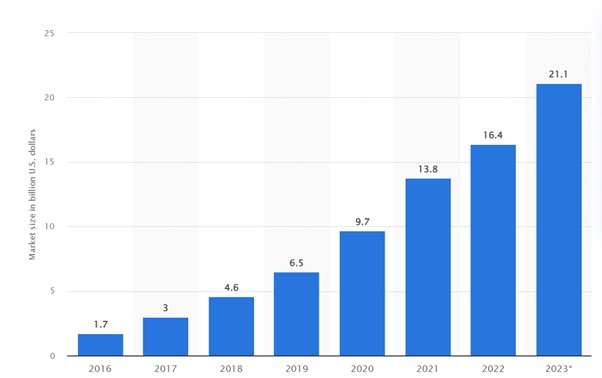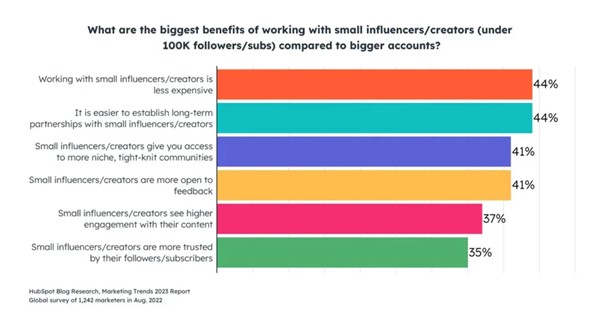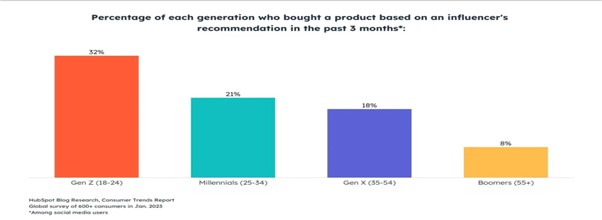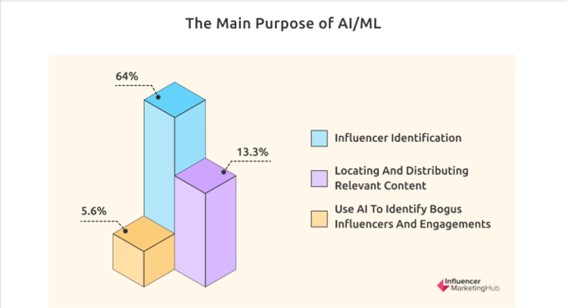

Dr Shruti Choudhary, Associate Professor, School of Business, Woxsen University Mr. Kulbir Singh, Sr. Director, Rooftop Digital
COO11
Feb2024
Introduction:
Remember the days when a celebrity endorsement could single-handedly launch a brand? Today's consumers are savvier, demanding authenticity and connection from the voices they trust. Influencer marketing has emerged as a powerful force, harnessing the influence of everyday experts and passionate creators to reach engaged audiences. Leveraging the power of social media influencers, brands can forge strategic partnerships that drive company growth. This marketing approach, adopted by countless businesses over the past decade, has witnessed consistent expansion. But navigating this dynamic landscape can be tricky. Is influencer marketing right for your brand? How do you identify the right partners and craft an effective campaign? What does the future hold for this ever-evolving field? This white paper cuts through the hype and delivers actionable insights.
Evolution of Influencer Marketing
Remember the Marlboro Man, effortlessly cool as he rode off into the sunset, cigarette dangling from his lips? That was influencer marketing's distant relative, relying on celebrity endorsements to sway a mass audience. Fast forward to today, and the landscape has radically transformed. We're no longer looking for manufactured excitement; we crave authenticity, connection, and community. Enter the era of influencer marketing, a rapidly evolving industry where everyday creators hold the power to shape consumer decisions. Influencer marketing has a rich history that dates back centuries, long before the advent of social media. Here's a brief overview of the evolution of influencer marketing:
Today, influencer marketing is a powerful strategy for brands looking to expand their reach, increase brand awareness, and boost conversions. In 2020, 69.8% of marketers planned to increase their influencer marketing budget.
From Humble Beginnings to Billion-Dollar Industry:
While influencer marketing as we know it emerged around the mid-2000s, its roots trace back further. Product placements in movies and sponsored blog posts laid the groundwork. However, the rise of social media platforms like Instagram and YouTube provided the fertile ground for influencer marketing to blossom. Today, it's a multi-billion dollar industry, projected to reach $84.89 billion by 2028. Global Influencer Market size was valued at USD 10.39 Billion in 2021 and is poised to grow from USD 13.86 Billion in 2022 to USD 139 Billion by 2030, at a CAGR of 33.4% during the forecast period (2023-2030).

Table 1: Influencer marketing market size worldwide from 2016 to 2023(in billion U.S. dollars)
Key Trends Shaping the Influencer Landscape:

Table 2: Benefits of working with small influencers

Table 3: Generation-wise Influencer Impact
The Impact of Data:
The influence of data on influencer marketing cannot be understated. A recent study by Influencer Marketing Hub found that 61% of marketers consider data and analytics to be very important in their decision-making process. Brands are increasingly using data to:

Table 4: Purpose of AI Tools in Influencer Marketing
Future Outlook of Influencer Marketing
The influencer marketing landscape is a dynamic tapestry woven with ever-evolving trends and shifting preferences. As we stand on the precipice of the future, the question arises: what lies ahead for this powerful marketing tool? To understand the answer, we must analysis into the emerging trends, expert predictions, and potential challenges that will shape its trajectory.
Metaverse Muses and Live Shopping Booms:
Virtual Influencers Take Center Stage: Imagine a world where AI-powered avatars with millions of followers promote products in immersive virtual environments. The Metaverse presents exciting possibilities for influencer marketing, with brands like Nike already experimenting with virtual ambassadors. Experts like Cathy Hackl, a technologist and author, predict the rise of "phygital" influencers, seamlessly blending physical and virtual realities.
Live Shopping Reigns Supreme: Platforms like TikTok LIVE and Instagram Shopping are making social media a powerful sales channel. Experts like Jason Dorsey, CMO of Publicis Sapient, believe live shopping will continue to boom, with influencers playing a pivotal role in driving sales through interactive product demonstrations and real-time engagement.
Shifting Power Dynamics and Evolving Regulations:
Micro and Nano Take the Lead: The power is shifting away from megastars and towards micro and nano-influencers. These niche creators boast higher engagement rates and deeper connections with their communities. A study by Influencer Marketing Hub reveals a 7.86% engagement rate for micro-influencers, compared to 1.7% for mega-influencers. Experts like Lee Odden, CEO of TopRank Marketing, believe brands should focus on building long-term partnerships with these "influencer tribes" for sustained impact.
Focus on Community Building: Consumers crave a sense of belonging. Brands will need to partner with influencers who can foster genuine communities around shared values and interests. Sarah Hofstetter, CEO of Obviously, emphasizes the importance of "influencer-led communities" where brands act as facilitators, not dictators.
Transparency and Ethics Drive the Future:
Evolving Regulations: Governments and platforms are introducing regulations around influencer disclosure and ethical practices. Brands must proactively comply with these evolving guidelines to maintain trust and avoid legal repercussions. Susan Boster, CEO of influencer marketing agency The Content Society, advises brands to be "hyper-vigilant" about compliance and ethical partnerships.
Sustainability Takes Root: Consumers are increasingly demanding environmental and social responsibility from brands and influencers alike. Partnerships that align with sustainable practices and ethical values will resonate more deeply with audiences. Influencer marketing agency Socialyte suggests brands should seek partners who promote "social good" and align with the UN's Sustainable Development Goals.
Data and Technology Fuel Smarter Strategies:
Advanced Analytics Take Over: Data-driven decision-making will be crucial for optimizing influencer campaigns. AI-powered tools will analyze vast datasets to identify ideal partners, measure campaign performance, and predict ROI. James Beswick, CEO of influencer marketing platform Traackr, believes AI will "democratize" influencer marketing by making data-driven insights accessible to all brands.
Blockchain Boosts Transparency: Blockchain technology can ensure authenticity and transparency in influencer marketing. Platforms like Fantom are already developing solutions for tracking campaign performance and ensuring influencer payments are fair and verifiable. Influencer marketing agency Social Chain believes blockchain will offer "increased transparency and trust" in the industry.
Conclusion
As the curtain closes on our glimpse into the future of influencer marketing, one thing remains clear: authenticity reigns supreme. Gone are the days of forced endorsements and fabricated personas. Consumers crave genuine connections, shared values, and a sense of community. The future belongs to micro and nano influencers, building tribes around shared passions and fostering trust with their honest perspectives. Live shopping explodes, powered by real-time engagement and the persuasive charm of trusted voices. But amidst the technological advancements and shifting dynamics, the human touch remains paramount. Brands must prioritize ethical partnerships, transparency, and social responsibility, aligning with causes resonating with both influencer and audience. Data and technology provide powerful tools for optimization, but genuine stories and human connection will be the lifeblood of success. Embrace the evolution, prioritize purpose, and remember, the future of influencer marketing is built on trust, authenticity, and the power of community. So, step into the future, not with the tools of manipulation, but with the open arms of collaboration and the genuine desire to connect. The reward will be loyalty, advocacy, and a brand narrative that resonates far beyond the fleeting trends of tomorrow.
References:
https://www.statista.com/topics/2496/influence-marketing/
https://influencermarketinghub.com/influencer-marketing-statistics/
https://thesocialshepherd.com/blog/influencer-marketing-statistics
Barbosa, B., Saura, J. R., Zekan, S. B., & Ribeiro-Soriano, D. (2023). Defining content marketing and its influence on online user behavior: a data-driven prescriptive analytics method. Annals of Operations Research, 1-26.
Biaudet, S. (2017). Influencer marketing as a marketing tool: The process of creating an Influencer Marketing Campaign on Instagram.
Coll, P., & Micó, J. L. (2019). Influencer Marketing in the Growth Hacking strategy of digital brands. Observatorio (OBS*), vol. 13, núm 2, 2019.
Dhun, & Dangi, H. K. (2023). Influencer marketing: Role of influencer credibility and congruence on brand attitude and eWOM. Journal of Internet Commerce, 22(sup1), S28-S72.
Han, X., Wang, L., & Fan, W. (2023). Cost-effective social media influencer marketing. INFORMS Journal on Computing, 35(1), 138-157.
Glenister, G. (2021). Influencer Marketing Strategy: How to create successful influencer marketing. Kogan Page Publishers.
Leung, F. F., Gu, F. F., & Palmatier, R. W. (2022). Online influencer marketing. Journal of the Academy of Marketing Science, 1-26.
Kadekova, Z., & Holienčinova, M. (2018). Influencer marketing as a modern phenomenon creating a new frontier of virtual opportunities. Communication Today, 9(2).